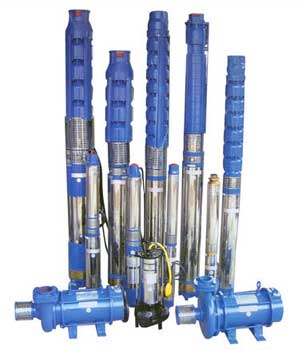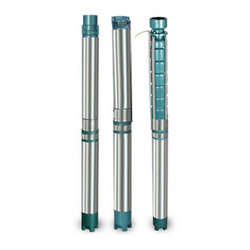A submersible pump (or electric submersible pump (ESP)) is a
device which has a hermetically sealed motor close-coupled
to the pump body. The whole assembly is submerged in the
fluid to be pumped. The main advantage of this type of pump
is that it prevents pump cavitation, a problem associated
with a high elevation difference between pump and the fluid
surface. Submersible pumps push fluid to the surface as
opposed to jet pumps having to pull fluids. Submersibles are
more efficient than jet pumps.
Working Principle :
The submersible pumps used in ESP installations are
multistage centrifugal pumps operating in a vertical
position. Although their constructional and operational
features underwent a continuous evolution over the years,
their basic operational principle remained the same.
Produced liquids, after being subjected to great centrifugal
forces caused by the high rotational speed of the impeller,
lose their kinetic energy in the diffuser where a conversion
of kinetic to pressure energy takes place. This is the main
operational mechanism of radial and mixed flow pumps.
The pump shaft is connected to the gas separator or the
protector by a mechanical coupling at the bottom of the
pump. Well fluids enter the pump through an intake screen
and are lifted by the pump stages.Other parts include the
radial bearings (bushings) distributed along the length of
the shaft providing radial support to the pump shaft turning
at high rotational speeds. An optional thrust bearing takes
up part of the axial forces arising in the pump but most of
those forces are absorbed by the protector’s thrust bearing.
Applications :
Submersible pumps are found in many applications. Single
stage pumps are used for drainage, sewage pumping, general
industrial pumping and slurry pumping. They are also popular
with aquarium filters. Multiple stage submersible pumps are
typically lowered down a borehole and used for water
abstraction, water wells and in oil wells.
Special attention to the type of ESP is required when using
certain types of liquids. ESP's commonly used on board naval
vessels cannot be used to dewater contaminated flooded
spaces. These use a 440 volt A/C motor that operates a small
centrifugal pump. It can also be used out of the water,
taking suction with a 2-1/2 inch non-collapsible hose. The
pumped liquid is circulated around the motor for cooling
purposes. There is a possibility that the gasoline will leak
into the pump causing a fire or destroying the pump, so hot
water and flammable liquids should be avoided.


